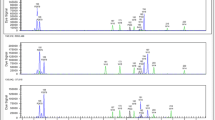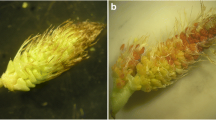Abstract
Segregating progenies of crosses between sexual and apomictic genotypes of Paspalum simplex were analysed for the formation of meiotic versus aposporous embryo sacs, zygotic versus parthenogenetic embryos, and autonomous versus pseudogamous endosperms by using cytoembryological and flow cytometric analyses. Reduced and unreduced 8-nucleated embryo sacs were the final product of female gametophyte development in sexual and aposporous genotypes, respectively. An incomplete penetrance of parthenogenesis was detected in aposporous genotypes. The relative DNA content of endosperm nuclei revealed the normal 2:1 maternal to paternal ratio in sexuals and a 4:1 ratio in apomicts, indicating insensitivity of the apomictic genotypes to endosperm imprinting. Apospory, parthenogenesis and pseudogamy are located on a relatively large linkage group and are inherited together with previously developed molecular markers as a single genetic unit in segregating progenies
Similar content being viewed by others
Author information
Authors and Affiliations
Additional information
Electronic Publication
Rights and permissions
About this article
Cite this article
Cáceres, M.E., Matzk, F., Busti, A. et al. Apomixis and sexuality in Paspalum simplex: characterization of the mode of reproduction in segregating progenies by different methods. Sex Plant Reprod 14, 201–206 (2001). https://doi.org/10.1007/s00497-001-0109-1
Received:
Accepted:
Published:
Issue Date:
DOI: https://doi.org/10.1007/s00497-001-0109-1




